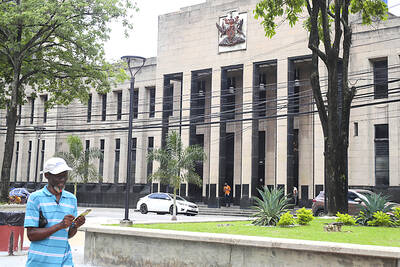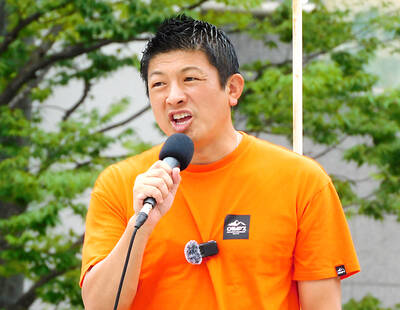Climate change is exposing reindeer hunting gear used by the Vikings’ ancestors faster than archeologists can collect it from ice thawing in northern Europe’s highest mountains.
“It’s like a time machine ... the ice has not been this small for many, many centuries,” said Lars Piloe, a Danish scientist heading a team of “snow patch archeologists” on newly bare ground 1,850m above sea level in mid-Norway.
Specialized hunting sticks, bows and arrows and even a 3,400-year-old leather shoe have been among finds since 2006 from a melt in the Jotunheimen mountains, the home of the “Ice Giants” of Norse mythology.
As water streams off the Juvfonna ice field, Piloe and two other archeologists — working in a science opening up due to climate change — collect “scare sticks” they reckon were set up 1,500 years ago in rows to drive reindeer toward archers.
However, time is short as the Ice Giants’ stronghold shrinks.
“Our main focus is the rescue part,” Piloe said on newly exposed rocks by the ice. “There are many ice patches. We can only cover a few ... We know we are losing artifacts everywhere.”
Freed from an ancient freeze, wood rots in a few years, and rarer feathers used on arrows, wool or leather crumble to dust in days unless taken to a laboratory and stored in a freezer.
Jotunheimen is unusual because so many finds are turning up at the same time — 600 artifacts at Juvfonna alone.
Other finds have been made in glaciers or permafrost from Alaska to Siberia. Italy’s iceman “Otzi,” killed by an arrow wound 5,000 years ago, was found in an Alpine glacier in 1991. “Ice Mummies” have been discovered in the Andes.
Patrick Hunt, of Stanford University in California, who is trying to discover where Carthaginian general Hannibal invaded Italy in 218BC with an army and elephants, said there was an “alarming rate” of thaw in the Alps.
“This is the first summer since 1994 when we began our Alpine field excavations above 8,000 ft [2,438m] that we have not been inundated by even one day of rain, sleet and snow flurries,” he said.
“I expect we will see more ‘ice patch archeology discoveries,’” he said.
Hannibal found snow on the Alpine pass he crossed in autumn, according to ancient writers.
Glaciers are in retreat from the Andes to the Alps, as a likely side-effect of global warming caused by human emissions of greenhouse gases, the UN panel of climate experts says.
The panel’s credibility has suffered since its 2007 report exaggerated a thaw by saying Himalayan glaciers might vanish by 2035. It has stuck to its main conclusion that it is “very likely” that human activities are to blame for global warming.
“Over the past 150 years we have had a worldwide trend of glacial retreat,” said Michael Zemp, director of the Swiss-based World Glacier Monitoring Service.
While many factors were at play, he said “the main driver is global warming.”
In Norway, “some ice fields are at their minimum for at least 3,000 years,” said Rune Strand Oedegaard, a glacier and permafrost expert from Norway’s Gjoevik University College.
The front edge of Jovfunna has retreated about 18m over the past year, exposing a band of artifacts probably from the Iron Age 1,500 years ago, according to radiocarbon dating. Others may be from Viking times 1,000 years ago.
Juvfonna, about 1km across on the flank of Norway’s highest peak, Galdhoepiggen, at 2,469m, also went through a less drastic shrinking period in the 1930s, Oedegaard said.
Inside the Juvfonna ice, experts have carved a cave to expose layers of ice dating back 6,000 years. Some dark patches turned out to be ancient reindeer droppings — giving off a pungent smell when thawed out.
Ice fields like Juvfonna differ from glaciers in that they do not slide much downhill. That means artifacts may be where they were left, giving insight into hunting techniques.
On Juvfonna, most finds are “scare sticks” about a meter long. Each has a separate, flapping piece of wood about 30cm long that was originally tied at the top. The thread is rarely found since it disintegrates within days of exposure.
“It’s a strange feeling to be tying a string around this stick just as someone else did maybe 1,500 years ago,” said Elling Utvik Wammer, an archeologist on Piloe’s team knotting a tag to a stick before storing it in a box for later study.
All the finds are also logged with a GPS satellite marker before being taken to the lab for examination.
The archeologists reckon they were set up about 2m apart to drive reindeer toward hunters. In summer, reindeer often go onto snow patches to escape parasitic flies.
Such a hunt would require 15 to 20 people, Piloe said, indicating that Norway had an organized society around the start of the Dark Ages, 1,500 years ago. Hunters probably needed to get within 20m of a reindeer to use an iron-tipped arrow.
“You can nearly feel the hunter here,” Piloe said, standing by a makeshift wall of rocks exposed in recent weeks and probably built by an ancient archer as a hideaway.

IDENTITY: A sex extortion scandal involving Thai monks has deeply shaken public trust in the clergy, with 11 monks implicated in financial misconduct Reverence for the saffron-robed Buddhist monkhood is deeply woven into Thai society, but a sex extortion scandal has besmirched the clergy and left the devout questioning their faith. Thai police this week arrested a woman accused of bedding at least 11 monks in breach of their vows of celibacy, before blackmailing them with thousands of secretly taken photos of their trysts. The monks are said to have paid nearly US$12 million, funneled out of their monasteries, funded by donations from laypeople hoping to increase their merit and prospects for reincarnation. The scandal provoked outrage over hypocrisy in the monkhood, concern that their status

The United States Federal Communications Commission said on Wednesday it plans to adopt rules to bar companies from connecting undersea submarine communication cables to the US that include Chinese technology or equipment. “We have seen submarine cable infrastructure threatened in recent years by foreign adversaries, like China,” FCC Chair Brendan Carr said in a statement. “We are therefore taking action here to guard our submarine cables against foreign adversary ownership, and access as well as cyber and physical threats.” The United States has for years expressed concerns about China’s role in handling network traffic and the potential for espionage. The U.S. has

Trinidad and Tobago declared a new state of emergency on Friday after authorities accused a criminal network operating in prisons across the country of plotting to kill key government officials and attack public institutions. It is the second state of emergency to be declared in the twin-island republic in a matter of months. In December last year, authorities took similar action, citing concerns about gang violence. That state of emergency lasted until mid-April. Police said that smuggled cellphones enabled those involved in the plot to exchange encrypted messages. Months of intelligence gathering led investigators to believe the targets included senior police officers,

A disillusioned Japanese electorate feeling the economic pinch goes to the polls today, as a right-wing party promoting a “Japanese first” agenda gains popularity, with fears over foreigners becoming a major election issue. Birthed on YouTube during the COVID-19 pandemic, spreading conspiracy theories about vaccinations and a cabal of global elites, the Sanseito Party has widened its appeal ahead of today’s upper house vote — railing against immigration and dragging rhetoric that was once confined to Japan’s political fringes into the mainstream. Polls show the party might only secure 10 to 15 of the 125 seats up for grabs, but it is